Well the shed was down and we were all set for a Saturday moving. The move was to occur in 2 stages. The first to get it off the mountain down all the narrow tracks through the bush, then the second was along the better roads to the marina. Well it sort of went like this, but the move got pushed forward. The saturday was to be wet, and more to the point the truck drivers had a Xmas BBQ to go too on Saturday. Anyway, Allan was in Woomera, but fortunately could get home by Friday lunch time. The truck had arrived before he did, but Nathan and I were there and we knew what to do. Nathan was doing a lot of the calculations, and Allan was on the phone when he could. But as soon as he arrived, just some minor adjustments were made and the boat was on the trailer. It was a special trailer which could lift the boat up and down about 2 metres. This turned out to be very important! Anyway, it then started its journey down the hill. There was 1 spotter, 1 driver and 2 clearers, and us. It was hot as hell too, with high humidity, just to make it easy. But no rain, but we could see it building. Anyway, it all went pretty smoothly down the hill. Some very narrow points where there was less than 50mm either side of the boat, but we got to the bottom in about 3hrs. Then it rained!
On the Saturday and Sunday we had to get a number of jobs done, but these were delayed by the weather. Also discovered a couple of leaks. It rained pretty hard! But we eventually got most things done in between the rain on Sunday. Then a few hours of sleep for some…. Then at 11:15pm we were all up and Allan was off to the boat now down the hill to get it ready for the truck and police escort. The truck arrived on time and very quickly we were on our way. The first issue we had to face was the creek. It was 30 metes away. So it was soon encountered…. In any case, after living here for 25 years, with the creek flooding whenever somebody swam in it, the council decided to fix the crossing. So they put in a very narrow temporary (very temporary) crossing whilst they ripped up the old bridge and put a new one in. So we had to cross the temporary crossing. It took about 15 minutes, with wheels over the edge both front and back and concerned looking removers… But to their credit they did it very very well (Look at Qld House Removers). Then we had the challenge of 6km of Cedar Creek Rd. You would not think it was that hard, but it was testing, with overhanging limbs, and telephone lines. We walked a lot of it! But then it got a lot easier, except for some intersections. Then finally we got to the highway, which has 2-3 lanes of traffic in one direction. The boat took up 2 lanes. We all followed in a convey, and all went smoothly, although some drivers were pretty stupid! But the police were very good. I could not praise them enough. They were interested and knew their stuff. Anyway, it took us 3.5hrs to get to the place of launch, were upon we had another 2 hrs of sleep, well some did…..
Then we needed to prepare the boat for launch. The mast was to go on, the rudders were to appear and be fitted, the propellers were to go on, then checks of the bilge pumps were to be completed and checks of the engine blower fans were to be made. Then we could launch. Not much to do, except we were very tired. Anyway, it went something like this. It was hot by 7am, and I mean very hot. The marina is right under the flight path for the Brisbane airport, and I mean the planes are not very high as they zoom over you. Great place for plane spotting… But not a good place to think or have a conversation. The rudders arrive, and they are all good. Somewhat of a surprise as they had never been fitted before and they were a design of Allan’s and made by his brother, Ross, and finished the day before. But they worked well and were the talk of the marina. Propellers went on and a bolt got its head stripped, but it was concluded that it would not come off (ever…). The mast was late, by 2 hrs. The checks then were performed, and they did not go well. Despite all the efforts we had put into it before, we had missed something. Allan tried to figure it out but was simply too tired and in the end decided in no uncertain terms that he had had enough and it was off for the day. All were disappointed, but in hindsight, it was the best decision of the day.
We came home and then Allan and Nathan discussed the problems that we were seeing with the electrics. A plan was developed to attack it the next day. A list of things to do and the order to do them in was made. Allan called it his procedures. I think this launch was being run like a rocket launch now! I suppose he knows how to do that, just a different direction of launch (down, not up!). So the list was printed and we set forth the next morning, nice and early. Evidently Allan slept, but I sure didn’t! So it was agreed that there were 3 issues to tackle. One was the blower, one was a bilge pump, and the other was a fuel leak. The fuel leak had to wait till it was in the water, because it clearly was only there when the engine was running. The blower was a bit serious as it evidently could be running on too high a voltage. This may have generated a fire. So it was attacked first. But then, we tried it in the configuration that it should have worked in, and it did! It performed perfectly. No issues at all. That was pretty perplexing to say the least, as all saw what happened yesterday. Anyway, it was determined that a switch position had been changed during the diagnostics yesterday, and what we were doing in the confusion of yesterday was turning the wrong switch on. So as per the procedures, tape came out and all switches were checked again and marked temporarily. Something we sort of had done, but not good enough. Ok, first problem solved. Then the bilge pump, which is rather important! Though, Will a friend with a similar boat, had kindly lent us a temporary pump, which would have worked. Anyway, Allan had a pretty good idea what was wrong here, because on the previous day he had spotted what was a fault. So he dove in to fix the fault, and sure enough it was wrong. But it still did not work…. So there was a second fault. There was simply no power to the pump, but the pump seemed perfectly ok. It was difficult to trace the wiring back to the switchboard as the bilge pumps are on a separate wire. An alternative was discussed, but then Allan had a look behind the switchboard, and he discovered a wire that was never terminated. I had put on it a label which said Watermaker. But we didn’t have a watermaker! Then the light bulb moment was seen in Allan’s face! “Ar yes, I remember now, I had wired up the pump on another circuit and it all worked fine, but then decided to change it, to make it more reliable, and I used the spare watermake line. I must not have terminated it….. (and got the connection at the other end wrong, Allan)”. So mystery solved and in time (according to the procedures…). So we informed the marina at 9am, that we were good to go. They asked us to have morning tea and they would then get us in the water.
We came back from morning tea to see the boat gone and ready to be put in the water. Those that were travelling on the boat had to get on, and the rest took pictures. It all went very smoothly and it hit the water around 10am 15th Dec 2015. The procedures then swung into action. Allan order the commands to Ross and Nathan and they diligently reporting back status of the various seals. All I could here was no leak here. That was good! Multiple checks were made, and we were deemed good. So time to start the engines! Ok, the procedures said to start the engine which did not have a suspected fuel leak. Best have a few wins I suppose. So the calls went out.
Allan “Starboard Battery on”
Nathan “Battery on”
Allan “Blower on”
Nathan “Blower is on”
Allan “Glowplug on, ok no need, it is too hot a day”
Allan” Turning instrumentation on”
Allan “Turning ignition on, you will here a buzzer, but don’t worry”
Allan “Clear to Start”
Nathan “Clear”
and start it did! A check was made if the water was flowing, and all was good. No apparent leaks, so it remained in idle for 5 minutes and then a little bit of revs to see how it may go, and it was all passed its checks. It was shut down and then port side followed the same procedure, except Nathan was to look for the fuel leak. Well it all went well and the leak was found. After about an hour we agreed we were ready to go. I was on the dock and did not go with them. But as the slings were finally removed, and the boat was set free, Allan had to get it out of this narrow area, without never steering this thing before in his life. I assume he was a little nervous, but he has been in lot worse places at work. So slings free, lets go, into gear, both engines, idle speed, but lets get out of here. A bit of a current running too, so a bit of thinking of how to handle it. Anyway, then lots of concerned shouts, and a realization that it is going backwards, not forward. Well before anybody could even ponder it, according to Allan, that meant that reverse must be forward. Not a lot of options here, as it is clearly going the wrong way!! So a very quick change, and yes they were off in the correct direction, current pretty strong, we here the engines rev up and it all was clear in seconds.
Launched and on our way………
The rest is now the beginning of a new story.
The final part of the journey by road
The rudders
Launched


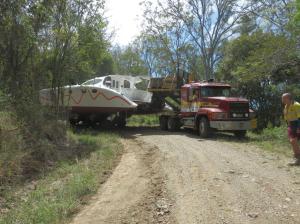

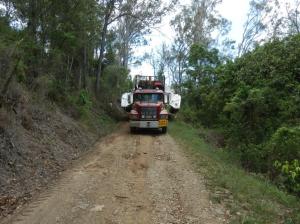

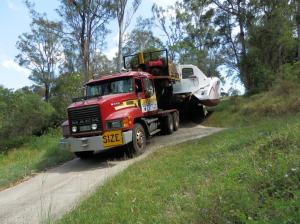


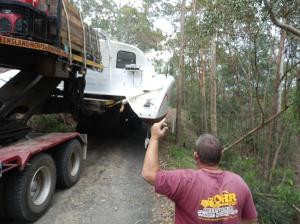
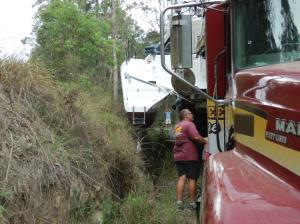
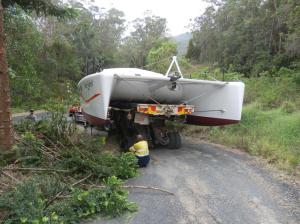










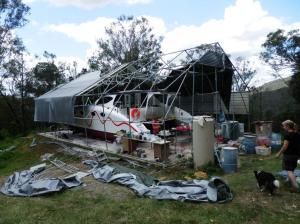
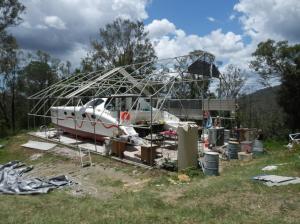






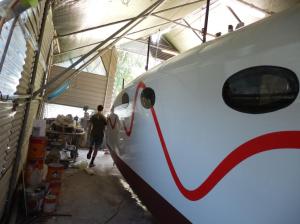


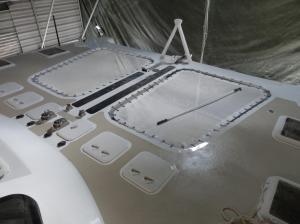
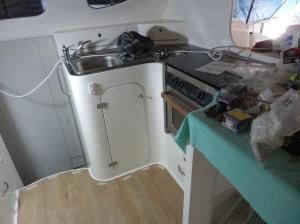

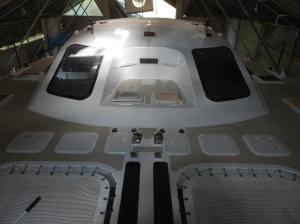

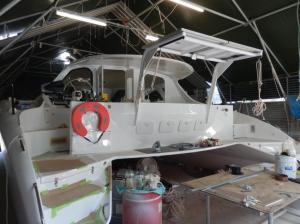
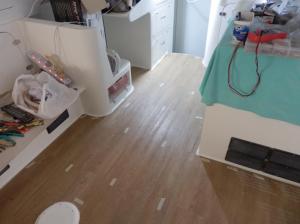





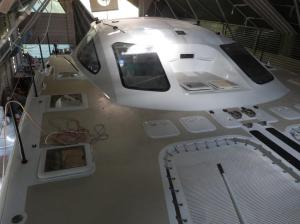



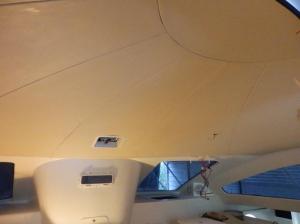



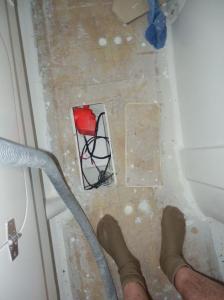

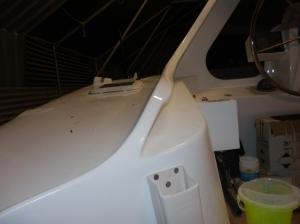

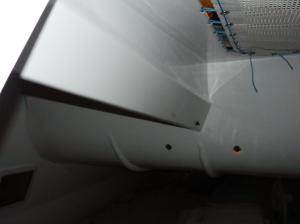

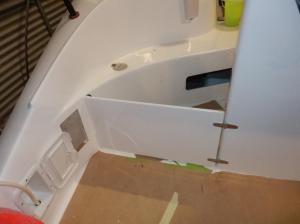




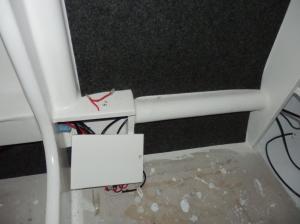






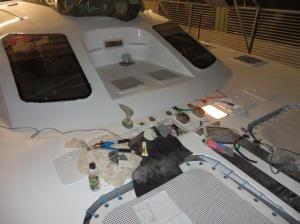

















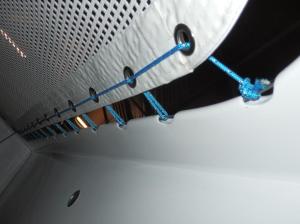


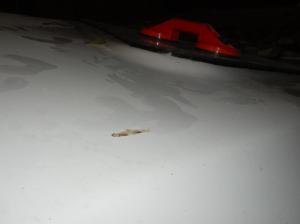




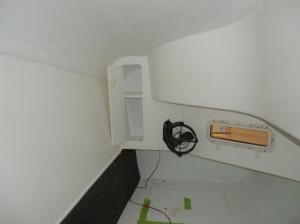




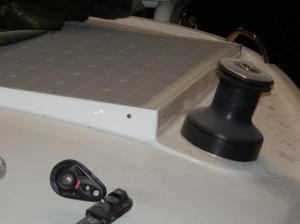

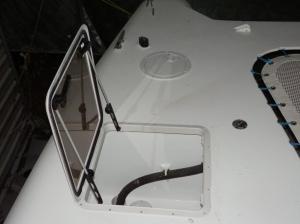










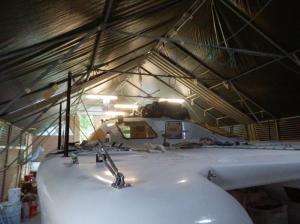
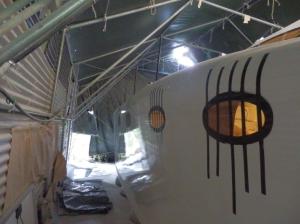


Recent Comments